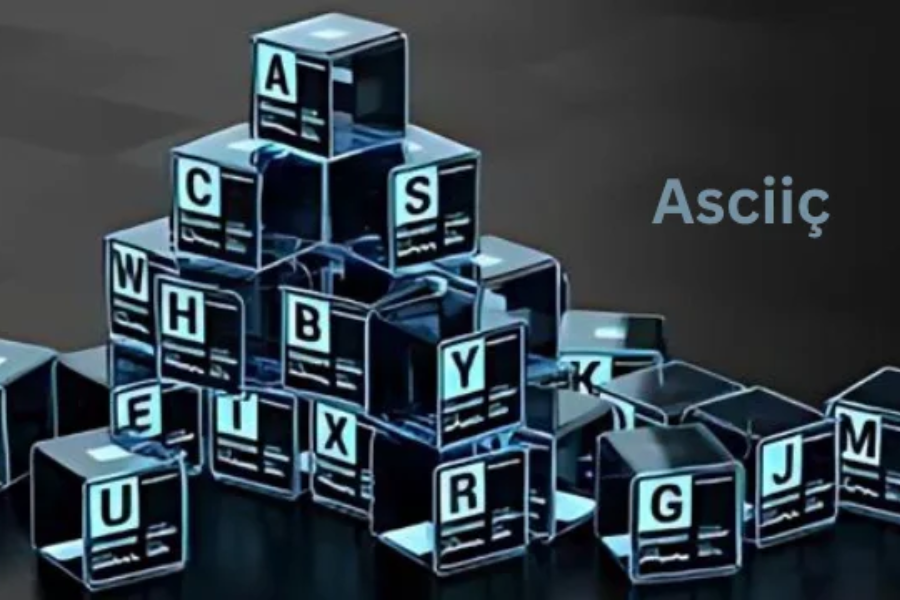Introduction
In the digital age, character encoding plays a pivotal role in ensuring that text is accurately represented and interpreted across different platforms and devices. Among the various character encoding schemes, ASCII (American Standard Code for Information Interchange) stands out as one of the earliest and most influential. Despite being overshadowed by more modern encodings, ASCII remains a fundamental component of text representation. This article delves into the world of ASCII, exploring its origins, structure, applications, and its enduring relevance in contemporary computing.
What is ASCII?
ASCII, which stands for American Standard Code for Information Interchange, is a character encoding standard that was designed to facilitate the representation of text in electronic devices. It provides a way to encode textual information into a format that computers can process and understand. The primary goal of ASCII is to standardize the way characters are represented, making it easier to exchange text data between different systems and devices.
The History of ASCII
The roots of ASCII trace back to the early 1960s when the American National Standards Institute (ANSI) spearheaded the development of a universal character encoding standard. Before ASCII, various character encoding schemes were in use, leading to incompatibility and confusion. ASCII was created to unify these disparate systems into a single, coherent standard. By merging existing character-set standards, ASCII aimed to provide a long-term solution for text representation across different platforms.
Introduced in 1968, ASCII quickly became the de facto standard for text representation, ensuring that different computer systems could communicate effectively. Its adoption marked a significant milestone in the development of digital communication and computing.
Structure and Design of ASCII
ASCII uses a 7-bit binary code to represent characters, which allows for a total of 128 unique values. Each ASCII character is assigned a specific number, which corresponds to a binary code. This efficient design was well-suited to the early computer systems, which had limited memory and processing power.
The 7-bit structure of ASCII means that it can represent up to 128 different characters. These characters are divided into two main categories:
- Control Characters (0-31): These are non-printable characters used in early teletypes to control various functions, such as line feeds and carriage returns. Although not visible in text, control characters play a crucial role in text formatting and processing.
- Printable Characters (32-126): This range includes alphanumeric characters (letters and digits), punctuation marks, and other symbols essential for text processing and representation.
The ASCII table also includes the BackSpace (127) character, which is used to move the cursor back one position. Although it is rarely used in modern text processing, it was important in the early days of computing.
ASCII Character Set
The ASCII character set comprises 128 unique characters, each represented by a specific number in the binary code. Here is a brief overview of some key categories within the ASCII character set:
- Control Characters (0-31): Includes characters such as the null character (NUL), start of header (SOH), and end of text (ETX). These characters are used for controlling hardware and text formatting.
- Printable Characters (32-126): This range includes:
- Space (32): The space character, essential for separating words and creating readable text.
- Uppercase Letters (65-90): A-Z
- Lowercase Letters (97-122): a-z
- Digits (48-57): 0-9
- Punctuation Marks and Symbols (33-47, 58-64, 91-96, 123-126): Includes characters like exclamation marks, commas, periods, and parentheses.
- BackSpace (127): Used to move the cursor back one position.
Applications of ASCII
ASCII has had a profound impact on various aspects of computing and data communication. Here are some of the key applications of ASCII:
Text Files
Plain text files are commonly encoded using ASCII. This allows for straightforward text representation and easy portability between different systems. ASCII encoding ensures that text files are compatible across various platforms and can be read and processed without issues.
Programming
In many programming languages, such as C and Python, ASCII is used to represent characters in source code. The simplicity and universality of ASCII make it an ideal choice for encoding textual data in programming contexts.
Internet Protocols
ASCII has been used extensively in internet protocols for representing text-based data. For example, HTTP headers, email headers, and URL encoding rely on ASCII characters to maintain compatibility and readability across different systems and networks.
Data Communication
ASCII is employed in data communication protocols to ensure that text-based data is transmitted and interpreted correctly. Its simplicity and standardization make it a reliable choice for representing textual information in various communication systems.
ASCII in Modern Computing
Despite the advent of more advanced encoding schemes like Unicode, ASCII remains relevant in modern computing. Its simplicity and efficiency make it suitable for certain applications, particularly in programming and data communication. Many modern character encoding standards, including Unicode, are designed to be backward-compatible with ASCII, ensuring that ASCII-encoded text can be seamlessly integrated into more complex systems.
Advantages of ASCII
ASCII offers several advantages that contribute to its continued use and importance:
Simplicity
The ASCII code is straightforward to implement, making it cost-effective for hardware and software development. Its simplicity also facilitates easy understanding and manipulation of text data.
Interoperability
ASCII is supported by virtually all computer systems and devices. Its widespread adoption ensures that text encoded in ASCII can be processed correctly across different platforms and technologies.
Efficiency
The compact representation of ASCII characters minimizes the amount of memory and processing power required. This efficiency was particularly valuable in the early days of computing when resources were limited.
Limitations of ASCII
While ASCII has been influential, it also has several limitations:
Limited Character Set
ASCII uses a 7-bit encoding scheme, which allows for only 128 characters. This limitation is insufficient for representing languages with larger character sets or for accommodating special symbols and characters used in other writing systems.
No Multilingual Support
ASCII is primarily designed for English and lacks support for characters from other languages. This limitation restricts its usability for international communication and diverse linguistic needs.
Extended ASCII and Beyond
To address the limitations of standard ASCII, Extended ASCII was developed. Extended ASCII uses an 8-bit encoding scheme, which allows for up to 256 characters. This extension includes additional characters for various languages and special symbols, providing greater versatility compared to standard ASCII.
Despite its improvements, Extended ASCII still falls short of accommodating the full range of global characters and symbols. This led to the development of more comprehensive character encoding standards, such as Unicode.
Unicode: The Next Generation for ASCII
Unicode represents the next generation of character encoding, designed to address the limitations of both ASCII and Extended ASCII. Unicode is a universal character encoding standard that can represent characters from virtually all writing systems, including a vast array of scripts, symbols, and emojis.
Unicode uses variable-length encoding schemes, such as UTF-8, to support a wide range of characters. With over a million unique character codes, Unicode provides a comprehensive solution for representing text in diverse languages and contexts.
One of the key strengths of Unicode is its backward compatibility with ASCII. The first 128 characters of Unicode are identical to ASCII, ensuring that ASCII-encoded text remains valid and readable within the Unicode framework.
ASCII Art: Characters Create Creativity
ASCII art is a creative technique that uses patterns of characters to create images and designs. Artists employ letters, digits, and symbols to craft intricate and imaginative representations. ASCII art was a popular form of digital art in the early days of computing and continues to be appreciated for its unique aesthetic.
The simplicity of ASCII art allows for the creation of visually appealing designs using only basic text characters. Despite its origins in early computing, ASCII art remains a testament to the creative potential of character encoding.
ASCII in Network Protocols
Many network protocols rely on ASCII characters for representing text data. For example, HTTP headers, email headers, and URL encoding use ASCII characters to maintain compatibility and readability across different systems and networks. This ensures that text-based data can be transmitted and interpreted accurately, regardless of the underlying technology.
Most Used ASCII Codes and Their Uses
Here are some of the most commonly used ASCII codes and their corresponding functions:
- 32 (Space): Represents the space character, used to separate words and create readable text.
- 33 (!): Exclamation mark, used for emphasis and punctuation.
- 65-90 (A-Z): Uppercase letters, used for alphabetic text.
- 97-122 (a-z): Lowercase letters, used for alphabetic text.
- 48-57 (0-9): Digits, used for numeric data.
- 13 (CR): Carriage Return, used to move the cursor to the beginning of a line.
- 10 (LF): Line Feed, used to move the cursor to the next line.
Future of Character Encoding
While Unicode is the dominant character encoding standard today, ASCII continues to influence modern computing. Its simplicity and foundational principles have shaped the development of subsequent encoding standards. As technology advances, new encoding standards may emerge, but ASCII’s legacy will remain a cornerstone of text representation.
Conclusion
ASCII has played a crucial role in the evolution of digital communication, providing a simple and effective means of representing text in electronic devices. Despite its limitations, ASCII’s impact on computing is undeniable, and its principles continue to inform modern encoding standards. By understanding the history and significance of ASCII, we gain a deeper appreciation for the role of character encoding in shaping the digital world.
FAQs
ASCII vs Unicode – The Ultimate Difference
ASCII (American Standard Code for Information Interchange) is a 7-bit character encoding standard that includes 128 characters, primarily focused on English letters, digits, and control characters. Unicode, on the other hand, is a universal encoding standard that supports over a million characters, covering virtually every script and symbol used in human languages. The first 128 characters of Unicode are identical to ASCII, making Unicode backward-compatible with ASCII.
Why is ASCII Still Used Today?
Despite the availability of more advanced encoding schemes, ASCII remains relevant due to its simplicity and widespread adoption. Many programming languages, protocols, and systems continue to use ASCII for its efficiency and ease of implementation. Additionally, ASCII’s straightforward nature makes it suitable for contexts with limited memory and processing power.
How Do Extended ASCII and Unicode Address the Limitations of Standard ASCII?
Extended ASCII builds on the original 7-bit encoding by using 8 bits to represent a total of 256 characters. This extension includes additional characters for various languages and special symbols. However, Unicode offers a more comprehensive solution with its variable-length encoding schemes and support for over a million characters. Unicode can represent a vast array of languages, symbols, and scripts, making it a global standard for text representation.



